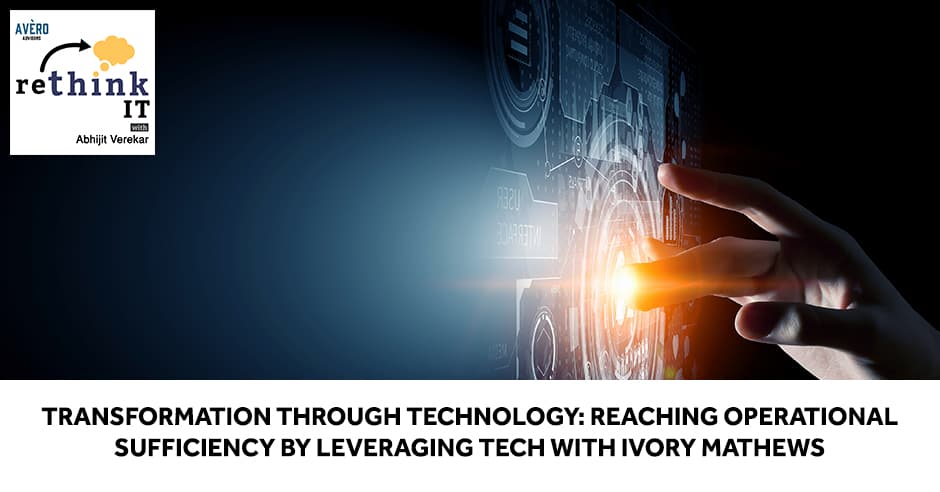Transformation Through Technology: Reaching Operational Sufficiency By Leveraging Tech With Ivory Mathews

How do you take a system inundated with outdated technology and bring it back to efficiency? You begin a transformation through technology, that’s how. In this episode, Abhijit Verekar gets into an informative conversation with Ivory Mathews, CEO of Columbia Housing, about transforming an antiquated system into a modern, efficient one. Ivory shares the experiences that led to her coming to work with Columbia Housing and how they are turning an antiquated system into a world-class one using technology. Interested in the transformations that can be done for your organization? Then tune in for more.
—
Listen to the podcast here:
Transformation Through Technology: Reaching Operational Sufficiency By Leveraging Tech With Ivory Mathews
We have Ms. Ivory Mathews, the Executive Director of the Columbia, South Carolina Housing Authority. Ivory, welcome to the show. Thank you for making time for this.
Thank you so much for having me, AV.
I’ve been following your LinkedIn and your profile for a little bit now, and I am very impressed with what you’ve done with your career, how much you do for your community and also public housing in general. You are the newly elected legislative body of SERC, correct?
Yes. I’m super excited about being the Legislative Chair for the Southeastern Regional Council – NAHRO. I have a lot of great people working along with me. Hopefully, when folks read this show, I’ll have more people to join us!
That’s the plan. You’re also involved in Carolina’s housing authorities. Tell us a little bit about that.
We have a trade organization, which consists of public housing authorities and community development entities. That organization is called Carolinas Council of Housing Redevelopment & Codes Officials. It covers the State of South Carolina and North Carolina. I’ve been elected by the membership to be the president-elect.
Congratulations. What’s your journey? How did you get into public housing and how did you end up in this leadership role?
How I ended up here was divine, when I think about my childhood growing up in rural South Carolina, it was not the best housing situation at all. I tell people now that I realize that the first time that I was in quality affordable housing was the day that I landed in college in a dorm room. It was not like the plush dorm rooms. I come from humble beginnings. We grew up in a mobile home. It was to the umpteenth degree because my daddy was the electrician. He was everything that we needed to make this place home.
To be successful, take “no” as just not right now. Share on XFast-forwarding, I went to college and had the fortunate opportunity of receiving my degree in Sociology. I knew at that time that I wanted to work in a place where my purpose and my passion met. I was fortunate enough to realize that at a very young age. I applied for a job at the housing authority. Needless to say, they did not hire me the first time I applied. Being the consistent person that I am, I had a meeting with the executive director and I said, “What is it that you’re looking for in your employees?” He told me. I appreciated that conversation because I did the work, but I did it through volunteer work.
My full time job was working at a community college in a career placement office. I did community work on the side so that I could get to know the community from the standpoint of what it would take to work with a housing authority. About a year or so after, the director ended up calling me back and offering me a job. It was the best decision I could have ever made in my life because it was where my passion and my purpose met. I truly love what I do, and I’m certainly excited about that.
Was that with Columbia Housing? Where was your first job?
This was the Aiken Housing Authority which is in South Carolina. It’s about an hour and a half south of the capital, which is Columbia, South Carolina. I spent ten years in Aiken. I started in compliance and then worked my way up to the CEO of the organization. I left there in 2011. I landed a position in Toledo, Ohio at the Lucas Metropolitan Housing Authority and spent some time there. I came back to South Carolina to Greenville. I spent five years in Greenville, and now I’m in Columbia. I’ve been here for the last few years.
Let’s talk about innovation and some innovative things that you’ve brought into your organizations. Throughout your many roles in Public Housing, I bet you’ve seen processes move from tons of paper to modernize systems. You’ve probably had a lot of influence on how those changes were made. Talk to me about how you think about innovation and how it applies to your industry.
I’m going to take Columbia as my example. When I landed the opportunity here in Columbia, it was July of 2019. I joined the agency right after an unfortunate circumstance happened, and honestly, four days in, I launched a twelve-month action plan.
I held a press conference. I invited the media and the local community. A big part of that twelve-month action plan was to do a complete analysis of the back-office operations. In completing that analysis of our back-office operations, I realized immediately that our organization was crippled significantly because of the antiquated technology systems.
As an example of the antiquation, all of the personal computers at the agency were at least ten years old or older. We had file servers that were no longer supported by Dell or any of the IT firms because they had reached their useful life. We were ordering parts for our phone system from any place that we could find them on the internet. Every single system technology-wise in the organization was completely outdated by a decade or more.

Transformation Through Technology: When technology is two decades behind, it requires a huge, healthy infusion of dollars to bring it up to speed.
It sounds like you were in a tough political environment at the time and there must have been a lot of noise. You were new to the organization and attempting this very ambitious initiative. How did you cut through the noise?
One of the things I realized early on, when you get a no, it means no, not right now. In our governance, there are opportunities for training a leadership team to understand what it means to bring in new systems. Our organization wasn’t just changing, we were going through a transformation, and that’s different.
When you go through a transformation, it flips you upside down. You’re doing a 360. You have to have fortitude and the strength to go through that. When I received no, as we were bringing forth the ideas for governance approval, I realized I needed to go back to the drawing board to be able to articulate it in a way to get the yeses.
There were a couple of roadblocks, but we’re there. We still have some work to do, but I’m excited about where we are right now. One of the things I am most grateful for was having that twelve-month action plan and making it public, which provided accountability. The public wanted to know where we were with this plan. It was an opportunity for us to make a decision, even if we were scared because we didn’t know we were entering into new territory. I say “we” as a group because even though I’ve been furtherly advanced with technology, I know that it can certainly be scary for those who aren’t.
It takes vision setting. You can be a leader in technology, but what you have to ask yourself is, what is the vision for you, your organization, and service delivery to your customers. Your customers are the ones that are in need. You can’t hold off housing subsidies because your technology sucks. With that in mind, How did you come up with the vision knowing that at the end of the day, your end customer is the one that needs to benefit from all of this?
Communication, it’s still something that we’re trying to make sure we perfect. When you’re operating an antiquated system, the only focus that you have is that your communication is narrowly focused on you having face-to-face contact. You understand the magnitude of what technology can bring to you. When you’re operationally sufficient, then you have a variety of different ways that you communicate with people.
One of the blessings- and I hate to say blessings- that came out of COVID-19 was that we were able to transition much sooner and quicker with the deployment of new technology. For one, we had to because healthcare recommendations forced us to eliminate face-to-face contact
We’ve had so much positive feedback from the people that we serve. For example, a customer wrote, “Thank you for allowing me to be able to access the website to go in and submit my income information. I don’t have to use my very unlimited resources to find transportation to come to sit in your office for four hours, waiting in a line behind twenty other people, to be able to see a person face to face.”
One of the blessings that came out of COVID-19 was that we were able to transition much sooner and quicker with the deployment of new technology. Share on XWe also did a survey and found that a lot of our families do have access to smartphones. Some of our consumers have never used a smartphone, and we have trained our consumers on how to use their smartphones to their full potential. We have virtual conversations with our consumers via smartphone as well. It’s certainly beneficial to our customer’s hands-down.
You said transformation, I loved your definition and the separation between that and change. Did you transform everything from the ground up? What was technology like when you made your twelve-month plan?
When I made my twelve-month plan, technology was at least two decades behind in the organization. It needed a complete overhaul. When technology is two decades behind, it requires you to have a huge, pretty healthy infusion of dollars to bring it up to speed. Preparing to have that conversation with our team was challenging. We had to make sure we had the resources first and foremost. We had to be accountable to the people that we serve and we had to make sure that their information is being protected at the highest standard that technology will allow. To me, this was a top priority. We had to do this.
Did you have the support in-house? What IT skillsets did you have on hand that you could tap into?
We made some changes internally with staffing in our IT department. We also brought on a third-party firm that could move as expeditiously as we needed to accomplish our goals. We still do have that combination. I like that combination. It’s a good combination for any organization to have separation of duties and responsibilities. In this day in time, a lot of companies can keep up with the most current systems to be able to protect data. These companies come in and give ideas on how to transition technology over the next 3 to 5 years . They help with developing a budget and a plan so that you and your organization can continue to move forward. We have a good team to move the agency in the direction that we need.
It gives you flexibility because you don’t want to be tied to a certain set of skill sets that may not be relevant five years from now. That’s encouraging. Keeping your team accountable is something that I always ask leaders about. You can vision cast all day, you can set goals and pave the path. How do you keep your team accountable for the larger goals that are made up of these smaller projects and activities?
We spend a lot of time communicating with our leadership team. That leadership team is made up of people who sit in all positions within the organization. They don’t necessarily have to have the job title of a director or a supervisor. We realize that every individual is uniquely qualified to be on the leadership team, despite the role that they play in the organization.
We have meetings with our leadership team monthly, and we have high-level conversations about our larger team goals. It’s a no-judgment zone. We talk freely and openly about areas where things may have changed, particular departments that may have been impacted, and goals that we have set collectively, and we make adjustments as we go along.

Transformation Through Technology: You don’t want to be tied to a certain set of skill sets that may not be relevant five years from now.
We realize that goals are things that you hope to accomplish, but if you don’t necessarily accomplish the goal within the time frame specified, it doesn’t mean that you’ve failed. It means that there’s something you need to adjust, or maybe you’ve been shooting too aggressively. We have won in our organization and then we have had Ls, which do not stand for losses. They’re learning opportunities. We take our Ls and we learn. Each time we have a barrier, a roadblock, a stumbling block, a technology block, we ask, “What can we do to learn, to make this change, to do something better?”
You don’t have a technology background. You’re not trained. You haven’t been a CIO. Does it then come down to looking past what I call the blinking lights and saying, “Here’s what the outcomes need to be. Let’s find the Lego blocks and the bricks to build this roadway to the outcome?”
I tell people I know enough about IT to be dangerous. It’s my career in another light. I focus on high-level goals. We’re very laser-focused in meeting our goals, but I’m also nimble enough to know you have to learn how to pivot and make adjustments when it’s necessary. I’m not unrealistic about what steps it might take for us to achieve goals.
I learn every day, and I tell people all the time, “I am not afraid to hire people who are way smarter than I am.” I love to hire people who are smarter than I am, because I learn something from every single person in my organization, regardless of what position they sit in. Bringing in talented people allows them to freely work towards the things that they feel will help us meet our goals in the end.
That leads me to the evolving role of the CIO, the CTO, or the IT director. How do you see this unfolding? A lot of my CIO friends don’t like me saying this, I don’t agree with the statement that as things become more automated, AI takes over. What is the role of a CIO? Is it growing into more of what you’re doing, vision setting, and setting goals? How do you see that evolving over time?
This is from my frame of reference, I encourage my colleagues, to not ever be afraid of understanding the magnitude and the benefits of what technology can bring to you. We’re in a different space and timeframe. COVID has certainly made all of us think about technology differently because we had to. If we maximize the uses of what technology can bring to us, we can all be better at serving the people that we serve. It’s a huge part of communicating.
A long time ago, people had to go to a bank. You had to go to the bank to do business. You had to go to a post office to do business. By all means, I’m not saying never go into these places to do business, but for people who have limited resources- like the people that we serve-it makes a world of difference for them to be in their homes handling their business without having to go out and find transportation and spend hours. It maximizes what people can do daily.
It also comes down to not being afraid to ask questions. My comment about you being not from a tech background, I’m not from one either. My background is in Accounting and Finance. For people in your position, it comes down to not being afraid to ask what may seem like a dumb question. It’s what gets you to the top too, not being afraid to ask the obvious questions.
Just because you don't accomplish a goal within the time frame specified doesn't mean that you've failed. It just means that there's something you need to adjust. Share on XSome people get hung up about the fact that they don’t have the background. You have a background in leadership and goal setting. That’s great to hear that you agree with me. You talked about the customers being the focal point of everything you do. What specific tenant-facing technologies did you put in at Columbia?
There are a couple of things that we’ve done. Before COVID, we hosted self-sufficiency workshops addressing a variety of different topics. They were all face-to-face and they were mostly at our community centers located within our various properties. We share our community centers with the citizens of our community.
We probably offered less than a dozen workshops a month. In a good month, we offered a dozen. Bringing in technology to be able to offer workshops virtually and having our partners on board to provide these workshop opportunities, we were able to offer hundreds of workshops to our residents. They can go online, sign up, and be engaged with the instructor from the comfort of their own home.
Through our workshops, we were able to coach twelve families on how to purchase their first home. When COVID hit, we had to transition these homeownership workshops to a virtual platform so that these twelve families could complete their homeownership workshop classes. I am happy to report that these families ended up purchasing a home during COVID-19.
These are some of the things that the advancement of technology has provided. For families, if there are income changes within their household, they can go online and submit their information to us virtually. We can go in and process their information and send an email back. We communicate with all of our families. They get text messages or emails from us, and we have the ability through our CMS database to push information out to specific groups regarding specific information. This has certainly been a huge benefit to communicating with our families.
How do you measure the success of this virtual space and everything you’re offering to your clients?
The success of the homeownership workshop was measured by having those families who attended, purchase a home. We also measure success by looking at analytical data from Google. Through Google, We can look at the number of unique visitors that are visiting our website. We can look at who is accessing our calendars, who is logging in to our workshops, and who is taking the class. I’m going to give you some examples. Before July of 2019 and the launch of our new website, we had less than 10,000 people a year visiting our website. I attributed that because it was very hard to navigate and find information.
In 2020, my first full year, we had 157,000 unique visitors visiting our website. In 2021, from January to October, we had 208,000 unique visitors visiting our website, and we had over ten million website hits. This means that people are intrigued by what we have to offer, and they are clicking through to find more information. We can drill down further in the data and look at other things too, but to me, this speaks volumes. This is more than just a website, it’s a business portal.
People are accessing our information to retrieve business, to do business, and to gain information. The new website gives us the ability to be able to have users or subscribers sign up for information. The last time I looked, we had over 40,000 subscribers to information on our website. That is a major accomplishment. That number grows every day.

Transformation Through Technology: For people who have limited resources, it makes a world of difference to be able to handle their businesses from home, without having to go out, find transportation, and spend hours of their time.
Do you attribute this success to COVID and a greater need, better systems on your end or is it both?
I attributed it to a combination of both. The verbal and written feedback that I have received from people is that they like that our information is easy to navigate and it’s transparent. The website focuses on a few principles that I launched during my initial joining the organization- increasing operational efficiency, transparency, and accountability. Transparency and accountability were two big focuses of mine, with the next being operational efficiency.
That’s all the questions I have. Do you have anything else to add, Ivory?
I want to say thank you for allowing me the time to talk about IT. A lot of times, when people think about government entities, in particular, they feel that these organizations are operating behind time. I want to say that there are a lot of people rethinking IT. I want to thank you so much for having this platform because it’s such a great tool for people who are trying to figure out where to start when it comes to rethinking IT, and it encourages them to take a look at and gain valuable information.
Thank you so much. That should be our catchphrase. I should use that. Can I use that?
Yes.
I’ll give you credit. Thank you so much for coming to the show. It’s always great to speak to like-minded people, especially in technology. I keep repeating myself, it’s not about technology. The gadgets exist. They will become better. It’s how you apply and make life better for your customers and workers. Thank you again.
Thank you so much.
Important Links:
- Columbia, South Carolina Housing Authority
- LinkedIn – Ivory Mathews
- Southeastern Regional Council – NAHRO
- Carolinas Council of Housing Redevelopment & Codes Officials
About Ivory Mathews
 Ivory N. Mathews is the Chief Executive Officer of Columbia Housing and Cayce Housing. Mathews has dedicated more than 20 years of her professional career to the affordable housing industry.
Ivory N. Mathews is the Chief Executive Officer of Columbia Housing and Cayce Housing. Mathews has dedicated more than 20 years of her professional career to the affordable housing industry.
Under Mathews’ leadership, Columbia Housing is putting residents first, rebuilding public trust, increasing organizational efficiency, and creating a climate of transparency and accountability. Using these principles, Columbia Housing has launched an aggressive $500 Million portfolio repositioning and redevelopment strategy with an unrelenting focus on the preservation and creation of quality affordable housing for the families they serve.
Mathews currently serves as the President-Elect of the Carolina’s Council of Housing, Redevelopment & Codes Officials (CCHRCO), Chair of the Legislative Committee of the Southeastern Regional Council of NAHRO (SERC-NAHRO), member of the City of Columbia’s Affordable Housing Taskforce, and a Congressional Contact for the National Association of Housing & Redevelopment Officials (NAHRO).
Mathews holds a Master’s Degree in Counseling & Psychology from Troy University, a Bachelor’s Degree in Sociology from Newberry College, and several nationally recognized certifications in the affordable housing arena. She is also a Riley Institute Diversity Leadership Initiative Fellow and has recently been named Top 20 Dynamic CEO’s for 2021 by The CEO Publication.
She is happily married for 19 years to Donnie Mathews; they are the proud parents of two children, Mahogany, 16, and Dalton, 11.
